
Carthage National Museum
Encyclopedia
Carthage National Museum, along with the Bardo National Museum one of the two main archaeological museums in Tunisia
, is a national museum
displaying archaeological items; it is sited at the hill of Byrsa in the heart of the city of Carthage
. Founded in 1875, it is one of the country's most extensive museums.
Located near the Cathedral of Saint-Louis of Carthage, it allows the visitor to appreciate the magnitude of the city during the Punic and Roman
eras. Some of the best pieces found in excavations are limestone/marble carvings, depicting animals, plants and even human sculptures. Of special note is a marble sarcophagus
of a priest and priestess from the 3rd century BC, discovered in the necropolis
of Carthage. The Museum also has a noted collection of masks and jewelry in cast glass, Roman mosaics including the famous "Lady of Carthage", a vast collection of Roman amphora
s. It also contains numerous local items from the period of the Byzantine Empire
. Also on display are objects of ivory
.


 The museum was founded in 1875 by Cardinal Charles Martial Lavigerie in the premises of the monastery
The museum was founded in 1875 by Cardinal Charles Martial Lavigerie in the premises of the monastery
; its name until 1956 was the Museum Lavigerie.
The museum is the product of excavations conducted by European archaeologists, in particular those made by Alfred Louis Delattre
. The Annex was used at first to house the items found in searches in the necropolis of Carthage and excavations of the St. Louis hill but also Douimès, the hill of Juno, the Sainte-Monique Hill and also the Carthaginian Christian basilicas. However, many object unearthed were sold to tourists when the museum had a number of examples of similar objects..
The museum received its present name in 1956 and opened for the first time as a national museum in 1963. It has undergone extensive restructuring in the 1990s, and has now been redesigned to accommodate new discoveries on the site of Carthage, especially the product of searches conducted as part of the international campaign of the UNESCO
, from 1972-1995.
 The various excavations at the site have uncovered numerous items characterizing the Phoenician civilization. The museum contains items which reveal a distinct connection with the Levant
The various excavations at the site have uncovered numerous items characterizing the Phoenician civilization. The museum contains items which reveal a distinct connection with the Levant
steeped in Egyptian and in particular Greek culture, and the ties of Carthage with Sicily
during the Hellenistic period. Testimonies to these connections are many objects of pottery
, oil lamps and amulet
s discovered in excavating the necropolis.
The museum has a fine collection of Punic ceramics found from the late 19th century. A number of lamps were found during the excavation of pottery kilns dating back to the Third Punic War
.
The amulet
s of Egyptian gods (Isis
, Osiris
, Horus
, and Bès
) indicates the importance of links between the Phoenicians and the Ancient Egypt
, the first retaining these cultural elements once they arrived in the Western Mediterranean.\

dating to the end of the Punic era, have been found in the necropolis
, notably the sarcophagus of the priest and the priestess, which is on display in the museum. The priest has the right hand raised in a gesture of blessing
The left hands of the two figures carry vases containing incense
for liturgical purposes
..
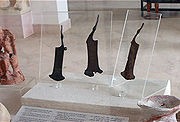 Masks of glass also represent numerous deities, including objects which were intended to protect the deceased against the evil eye
Masks of glass also represent numerous deities, including objects which were intended to protect the deceased against the evil eye
. There are also various items including razor
s made of bronze and richly decorated with cast patterns, illustrating Egyptian and Greek influences . A number of Punic amulets are also on display.
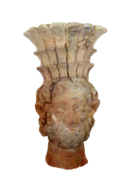
Les stèles du tophet constituent quant à elles la collection la plus importante qui soit disponible. Bien que des stèles furent signalées dès les premières recherches sur le site de Carthage, en particulier lors des fouilles de Pricot de Sainte Marie (1874), dont la plupart coulèrent avec le Magenta en 1875, de nombreuses pièces parmi les plus intéressantes sont déposées au musée après la découverte du sanctuaire en 1921. Outre les stèles plus communes en grès d’El Haouaria
, les stèles de calcaire plus tardives font l’objet le plus souvent de décors variés : navires, palmiers, éléphants voire éléments de portraits à forte influence hellénistique. Parfois, une inscription est présente sur la stèle.
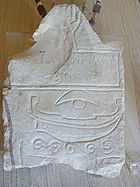 Des masques en forme de tête de Ba'al Hammon sont également exposés, en particulier un grand masque découvert par le docteur Louis Carton au début du 20th century]].
Des masques en forme de tête de Ba'al Hammon sont également exposés, en particulier un grand masque découvert par le docteur Louis Carton au début du 20th century]].
Le contenu de la « chapelle Cintas », découverte au tophet par Pierre Cintas en 1947, fait l’objet d’une vitrine propre. Deux dépôts de foundation contenant surtout des céramiques y furent découverts, l’un situé à la base d’un mur et l’autre dénommée « cachette » se trouvait sous le sol d’une petite pièce voûtée.
 There are some architectural elements of the Punic city on display, especially fragments of columns and pillars and structures.
There are some architectural elements of the Punic city on display, especially fragments of columns and pillars and structures.
Also outlined is a Phoenician inscription on black marble called "registration édilitaire", found in 1954..
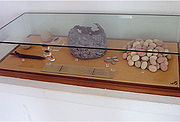 The history of the Roman city of Carthage begins with a disaster, the will to destroy a rival dating from 146, which has some moving testimonies from the period on showcase. Common items on display are bullet
The history of the Roman city of Carthage begins with a disaster, the will to destroy a rival dating from 146, which has some moving testimonies from the period on showcase. Common items on display are bullet
s, sword
s and stone catapult
s. A skeleton of one of fighters who died violently, is also exposed.
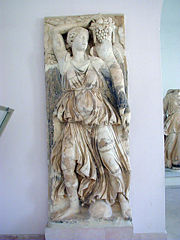
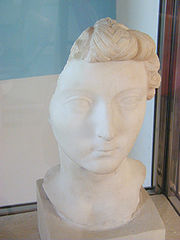 Elements of the official Roman art were discovered on the Byrsa hill, including sculptures and bas reliefs
Elements of the official Roman art were discovered on the Byrsa hill, including sculptures and bas reliefs
depicting victory. These excavated items have been interpreted as a commemoration of the victory over the Parthians in 166, during the reign of Marcus Aurelius and presented on a triumphal arch or monument portal..
In addition, works from the reign of Augustus
are presented including numerous busts. A remarkable representation of Auriga
, holding a whip and a jug, a symbol of victory, is also exposed. This recent discovery is a valuable testimony to the attention of the Roman circus in the city, which was the second in size after the Circus Maximus
in Rome..
s of the museum are not comparable to those of Bardo National Museum, the fact remains that genuine masterpieces are found in the museum. Among the recent discoveries, are from the panels found in a private spa located in Sidi Ghrib, near Tunis
. It represents a topless woman running through a rose garden surrounded by water..On the same site a panel of marble and limestone was discovered showing the activity of a matron at the end of the bath. It shows the individual seated on the toilet, surrounded by two servants, one of which holds a mirror and the other carrying a basket with various jewels. At the ends of the mosaic, the artist presents the bath accessories: a pair of sandals, a basket of laundry, a jug, etc..
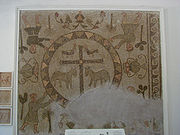 The mosaic of the four evangelists discovered in Carthage represents each of the four evangelists. In the center is a sphere in which integrates a cross
The mosaic of the four evangelists discovered in Carthage represents each of the four evangelists. In the center is a sphere in which integrates a cross
. This work symbolizes the triumph of Christianity
and its distribution to the four cardinal points by Liliane Ennabli .
Features of African Christianity at the time, such as ceramic tiles decorated with religious motifs were also excavated and are on display. Many of them are relatively large with decorative details which were intended to depict of the themes of the Old Testament
including Daniel and the Lion's Den.
A large number of funerary inscriptions discovered by Alfred Louis Delattre
are displayed in the Carthage museum, found during his excavation of the main basilica.
.jpg)
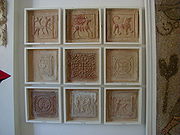 The famous "Lady of Carthage" mosaic dated back probably to the 6th century, is traditionally regarded as a portrait of a Byzantine emperor. The technique of alternating mosaic tiles and glass tiles, the fineness of the design and elegance of the subject makea it a major piece of art mosaic from the Late Antiquity.
The famous "Lady of Carthage" mosaic dated back probably to the 6th century, is traditionally regarded as a portrait of a Byzantine emperor. The technique of alternating mosaic tiles and glass tiles, the fineness of the design and elegance of the subject makea it a major piece of art mosaic from the Late Antiquity.
Tunisia
Tunisia , officially the Tunisian RepublicThe long name of Tunisia in other languages used in the country is: , is the northernmost country in Africa. It is a Maghreb country and is bordered by Algeria to the west, Libya to the southeast, and the Mediterranean Sea to the north and east. Its area...
, is a national museum
National museum
A national museum is a museum maintained by a nation.The following is a list of national museums:-Australia:*Australian National Aviation Museum*Australian National Maritime Museum*, Sydney*Australian War Memorial*Museum Victoria...
displaying archaeological items; it is sited at the hill of Byrsa in the heart of the city of Carthage
Carthage
Carthage , implying it was a 'new Tyre') is a major urban centre that has existed for nearly 3,000 years on the Gulf of Tunis, developing from a Phoenician colony of the 1st millennium BC...
. Founded in 1875, it is one of the country's most extensive museums.
Located near the Cathedral of Saint-Louis of Carthage, it allows the visitor to appreciate the magnitude of the city during the Punic and Roman
Ancient Rome
Ancient Rome was a thriving civilization that grew on the Italian Peninsula as early as the 8th century BC. Located along the Mediterranean Sea and centered on the city of Rome, it expanded to one of the largest empires in the ancient world....
eras. Some of the best pieces found in excavations are limestone/marble carvings, depicting animals, plants and even human sculptures. Of special note is a marble sarcophagus
Sarcophagus
A sarcophagus is a funeral receptacle for a corpse, most commonly carved or cut from stone. The word "sarcophagus" comes from the Greek σαρξ sarx meaning "flesh", and φαγειν phagein meaning "to eat", hence sarkophagus means "flesh-eating"; from the phrase lithos sarkophagos...
of a priest and priestess from the 3rd century BC, discovered in the necropolis
Necropolis
A necropolis is a large cemetery or burial ground, usually including structural tombs. The word comes from the Greek νεκρόπολις - nekropolis, literally meaning "city of the dead"...
of Carthage. The Museum also has a noted collection of masks and jewelry in cast glass, Roman mosaics including the famous "Lady of Carthage", a vast collection of Roman amphora
Amphora
An amphora is a type of vase-shaped, usually ceramic container with two handles and a long neck narrower than the body...
s. It also contains numerous local items from the period of the Byzantine Empire
Byzantine Empire
The Byzantine Empire was the Eastern Roman Empire during the periods of Late Antiquity and the Middle Ages, centred on the capital of Constantinople. Known simply as the Roman Empire or Romania to its inhabitants and neighbours, the Empire was the direct continuation of the Ancient Roman State...
. Also on display are objects of ivory
Ivory
Ivory is a term for dentine, which constitutes the bulk of the teeth and tusks of animals, when used as a material for art or manufacturing. Ivory has been important since ancient times for making a range of items, from ivory carvings to false teeth, fans, dominoes, joint tubes, piano keys and...
.
History of the museum



Monastery
Monastery denotes the building, or complex of buildings, that houses a room reserved for prayer as well as the domestic quarters and workplace of monastics, whether monks or nuns, and whether living in community or alone .Monasteries may vary greatly in size – a small dwelling accommodating only...
; its name until 1956 was the Museum Lavigerie.
The museum is the product of excavations conducted by European archaeologists, in particular those made by Alfred Louis Delattre
Alfred Louis Delattre
Alfred Louis Delattre was a French archaeologist, born at Déville-lès-Rouen. Sent as a missionary to Algeria, he became chaplain of the church of St. Louis of Carthage and conservator of the archaeological museum at Algiers. His investigations among the ruins of ancient Carthage were very valuable...
. The Annex was used at first to house the items found in searches in the necropolis of Carthage and excavations of the St. Louis hill but also Douimès, the hill of Juno, the Sainte-Monique Hill and also the Carthaginian Christian basilicas. However, many object unearthed were sold to tourists when the museum had a number of examples of similar objects..
The museum received its present name in 1956 and opened for the first time as a national museum in 1963. It has undergone extensive restructuring in the 1990s, and has now been redesigned to accommodate new discoveries on the site of Carthage, especially the product of searches conducted as part of the international campaign of the UNESCO
UNESCO
The United Nations Educational, Scientific and Cultural Organization is a specialized agency of the United Nations...
, from 1972-1995.
Phoenician

Levant
The Levant or ) is the geographic region and culture zone of the "eastern Mediterranean littoral between Anatolia and Egypt" . The Levant includes most of modern Lebanon, Syria, Jordan, Israel, the Palestinian territories, and sometimes parts of Turkey and Iraq, and corresponds roughly to the...
steeped in Egyptian and in particular Greek culture, and the ties of Carthage with Sicily
Sicily
Sicily is a region of Italy, and is the largest island in the Mediterranean Sea. Along with the surrounding minor islands, it constitutes an autonomous region of Italy, the Regione Autonoma Siciliana Sicily has a rich and unique culture, especially with regard to the arts, music, literature,...
during the Hellenistic period. Testimonies to these connections are many objects of pottery
Pottery
Pottery is the material from which the potteryware is made, of which major types include earthenware, stoneware and porcelain. The place where such wares are made is also called a pottery . Pottery also refers to the art or craft of the potter or the manufacture of pottery...
, oil lamps and amulet
Amulet
An amulet, similar to a talisman , is any object intended to bring good luck or protection to its owner.Potential amulets include gems, especially engraved gems, statues, coins, drawings, pendants, rings, plants and animals; even words said in certain occasions—for example: vade retro satana—, to...
s discovered in excavating the necropolis.
The museum has a fine collection of Punic ceramics found from the late 19th century. A number of lamps were found during the excavation of pottery kilns dating back to the Third Punic War
Third Punic War
The Third Punic War was the third and last of the Punic Wars fought between the former Phoenician colony of Carthage, and the Roman Republic...
.
The amulet
Amulet
An amulet, similar to a talisman , is any object intended to bring good luck or protection to its owner.Potential amulets include gems, especially engraved gems, statues, coins, drawings, pendants, rings, plants and animals; even words said in certain occasions—for example: vade retro satana—, to...
s of Egyptian gods (Isis
Isis
Isis or in original more likely Aset is a goddess in Ancient Egyptian religious beliefs, whose worship spread throughout the Greco-Roman world. She was worshipped as the ideal mother and wife as well as the matron of nature and magic...
, Osiris
Osiris
Osiris is an Egyptian god, usually identified as the god of the afterlife, the underworld and the dead. He is classically depicted as a green-skinned man with a pharaoh's beard, partially mummy-wrapped at the legs, wearing a distinctive crown with two large ostrich feathers at either side, and...
, Horus
Horus
Horus is one of the oldest and most significant deities in the Ancient Egyptian religion, who was worshipped from at least the late Predynastic period through to Greco-Roman times. Different forms of Horus are recorded in history and these are treated as distinct gods by Egyptologists...
, and Bès
Bes
Bes was an Egyptian deity worshipped in the later periods of dynastic history as a protector of households and in particular mothers and children. In time he would be regarded as the defender of everything good and the enemy of all that is bad...
) indicates the importance of links between the Phoenicians and the Ancient Egypt
Ancient Egypt
Ancient Egypt was an ancient civilization of Northeastern Africa, concentrated along the lower reaches of the Nile River in what is now the modern country of Egypt. Egyptian civilization coalesced around 3150 BC with the political unification of Upper and Lower Egypt under the first pharaoh...
, the first retaining these cultural elements once they arrived in the Western Mediterranean.\

Funeral objects
Beautiful sarcophagiSarcophagus
A sarcophagus is a funeral receptacle for a corpse, most commonly carved or cut from stone. The word "sarcophagus" comes from the Greek σαρξ sarx meaning "flesh", and φαγειν phagein meaning "to eat", hence sarkophagus means "flesh-eating"; from the phrase lithos sarkophagos...
dating to the end of the Punic era, have been found in the necropolis
Necropolis
A necropolis is a large cemetery or burial ground, usually including structural tombs. The word comes from the Greek νεκρόπολις - nekropolis, literally meaning "city of the dead"...
, notably the sarcophagus of the priest and the priestess, which is on display in the museum. The priest has the right hand raised in a gesture of blessing
Blessing
A blessing, is the infusion of something with holiness, spiritual redemption, divine will, or one's hope or approval.- Etymology and Germanic paganism :...
The left hands of the two figures carry vases containing incense
Incense
Incense is composed of aromatic biotic materials, which release fragrant smoke when burned. The term "incense" refers to the substance itself, rather than to the odor that it produces. It is used in religious ceremonies, ritual purification, aromatherapy, meditation, for creating a mood, and for...
for liturgical purposes
Liturgy
Liturgy is either the customary public worship done by a specific religious group, according to its particular traditions or a more precise term that distinguishes between those religious groups who believe their ritual requires the "people" to do the "work" of responding to the priest, and those...
..

Evil eye
The evil eye is a look that is believed by many cultures to be able to cause injury or bad luck for the person at whom it is directed for reasons of envy or dislike...
. There are also various items including razor
Razor
A razor is a bladed tool primarily used in the removal of unwanted body hair through the act of shaving. Kinds of razors include straight razors, disposable razors and electric razors....
s made of bronze and richly decorated with cast patterns, illustrating Egyptian and Greek influences . A number of Punic amulets are also on display.

Punic religion
The terracotta perfume-burner in the form of the head of Ba'al Hammon was discovered in a sanctuary in the Salammbô quarter unearthed by Dr Louis Carton shortly after World War I.; at the same time diverse other cultural objects came to light, including representations of DemeterDemeter
In Greek mythology, Demeter is the goddess of the harvest, who presided over grains, the fertility of the earth, and the seasons . Her common surnames are Sito as the giver of food or corn/grain and Thesmophoros as a mark of the civilized existence of agricultural society...
Les stèles du tophet constituent quant à elles la collection la plus importante qui soit disponible. Bien que des stèles furent signalées dès les premières recherches sur le site de Carthage, en particulier lors des fouilles de Pricot de Sainte Marie (1874), dont la plupart coulèrent avec le Magenta en 1875, de nombreuses pièces parmi les plus intéressantes sont déposées au musée après la découverte du sanctuaire en 1921. Outre les stèles plus communes en grès d’El Haouaria
El Haouaria
El Haouaria is a coastal town and commune in the Nabeul Governorate, Tunisia. As of 2004 it had a population of 9,273.-References:...
, les stèles de calcaire plus tardives font l’objet le plus souvent de décors variés : navires, palmiers, éléphants voire éléments de portraits à forte influence hellénistique. Parfois, une inscription est présente sur la stèle.

Le contenu de la « chapelle Cintas », découverte au tophet par Pierre Cintas en 1947, fait l’objet d’une vitrine propre. Deux dépôts de foundation contenant surtout des céramiques y furent découverts, l’un situé à la base d’un mur et l’autre dénommée « cachette » se trouvait sous le sol d’une petite pièce voûtée.
Punic architecture

Also outlined is a Phoenician inscription on black marble called "registration édilitaire", found in 1954..
Evidence of the 146 battle: The remains of the siege

Bullet
A bullet is a projectile propelled by a firearm, sling, or air gun. Bullets do not normally contain explosives, but damage the intended target by impact and penetration...
s, sword
Sword
A sword is a bladed weapon used primarily for cutting or thrusting. The precise definition of the term varies with the historical epoch or the geographical region under consideration...
s and stone catapult
Catapult
A catapult is a device used to throw or hurl a projectile a great distance without the aid of explosive devices—particularly various types of ancient and medieval siege engines. Although the catapult has been used since ancient times, it has proven to be one of the most effective mechanisms during...
s. A skeleton of one of fighters who died violently, is also exposed.
Roman art


Relief
Relief is a sculptural technique. The term relief is from the Latin verb levo, to raise. To create a sculpture in relief is thus to give the impression that the sculpted material has been raised above the background plane...
depicting victory. These excavated items have been interpreted as a commemoration of the victory over the Parthians in 166, during the reign of Marcus Aurelius and presented on a triumphal arch or monument portal..
In addition, works from the reign of Augustus
Augustus
Augustus ;23 September 63 BC – 19 August AD 14) is considered the first emperor of the Roman Empire, which he ruled alone from 27 BC until his death in 14 AD.The dates of his rule are contemporary dates; Augustus lived under two calendars, the Roman Republican until 45 BC, and the Julian...
are presented including numerous busts. A remarkable representation of Auriga
Auriga (slave)
In Ancient Rome, the Auriga was a slave whose duty was to drive a biga, the light vehicle powered by two horses, to transport some important Romans, mainly Duces ; it was then a sort of chauffeur for important men, and was carefully selected among trustworthy slaves only.It has been supposed also...
, holding a whip and a jug, a symbol of victory, is also exposed. This recent discovery is a valuable testimony to the attention of the Roman circus in the city, which was the second in size after the Circus Maximus
Circus Maximus
The Circus Maximus is an ancient Roman chariot racing stadium and mass entertainment venue located in Rome, Italy. Situated in the valley between the Aventine and Palatine hills, it was the first and largest stadium in ancient Rome and its later Empire...
in Rome..
Mosaics
Although the collections of mosaicMosaic
Mosaic is the art of creating images with an assemblage of small pieces of colored glass, stone, or other materials. It may be a technique of decorative art, an aspect of interior decoration, or of cultural and spiritual significance as in a cathedral...
s of the museum are not comparable to those of Bardo National Museum, the fact remains that genuine masterpieces are found in the museum. Among the recent discoveries, are from the panels found in a private spa located in Sidi Ghrib, near Tunis
Tunis
Tunis is the capital of both the Tunisian Republic and the Tunis Governorate. It is Tunisia's largest city, with a population of 728,453 as of 2004; the greater metropolitan area holds some 2,412,500 inhabitants....
. It represents a topless woman running through a rose garden surrounded by water..On the same site a panel of marble and limestone was discovered showing the activity of a matron at the end of the bath. It shows the individual seated on the toilet, surrounded by two servants, one of which holds a mirror and the other carrying a basket with various jewels. At the ends of the mosaic, the artist presents the bath accessories: a pair of sandals, a basket of laundry, a jug, etc..
Testimonies of Ancient Christianity

Crucifix
A crucifix is an independent image of Jesus on the cross with a representation of Jesus' body, referred to in English as the corpus , as distinct from a cross with no body....
. This work symbolizes the triumph of Christianity
Christianity
Christianity is a monotheistic religion based on the life and teachings of Jesus as presented in canonical gospels and other New Testament writings...
and its distribution to the four cardinal points by Liliane Ennabli .
Features of African Christianity at the time, such as ceramic tiles decorated with religious motifs were also excavated and are on display. Many of them are relatively large with decorative details which were intended to depict of the themes of the Old Testament
Old Testament
The Old Testament, of which Christians hold different views, is a Christian term for the religious writings of ancient Israel held sacred and inspired by Christians which overlaps with the 24-book canon of the Masoretic Text of Judaism...
including Daniel and the Lion's Den.
A large number of funerary inscriptions discovered by Alfred Louis Delattre
Alfred Louis Delattre
Alfred Louis Delattre was a French archaeologist, born at Déville-lès-Rouen. Sent as a missionary to Algeria, he became chaplain of the church of St. Louis of Carthage and conservator of the archaeological museum at Algiers. His investigations among the ruins of ancient Carthage were very valuable...
are displayed in the Carthage museum, found during his excavation of the main basilica.
Byzantine Civilisation
.jpg)


